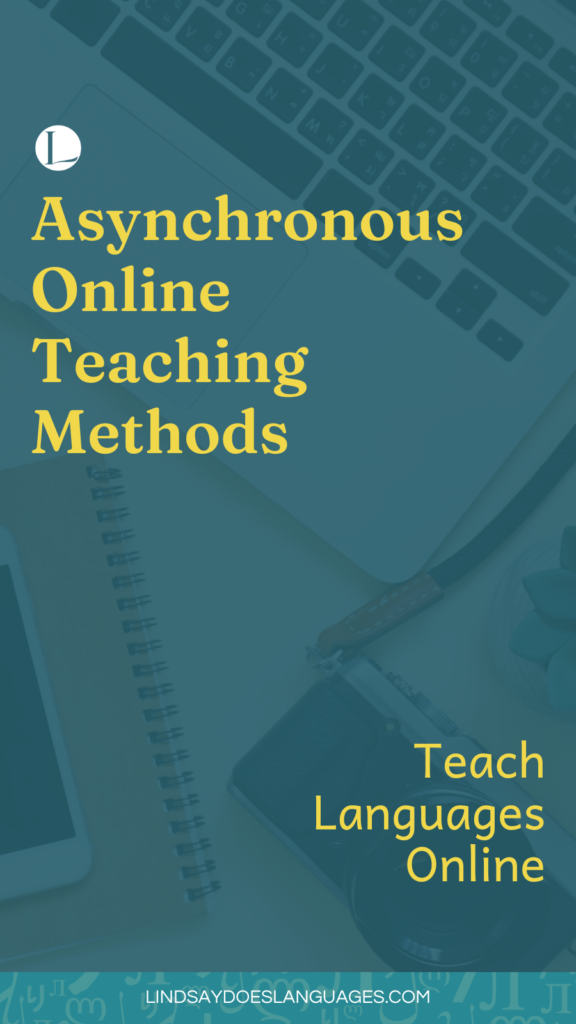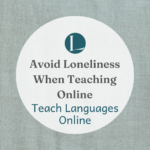Blog Podcast Teach Languages Online
August 23rd, 2023
Asynchronous Teaching Methods for Better Offers Without Risky Results
Asynchronous teaching is the future of teaching languages online. In this episode, we’ll cover how you can teach online with asynchronous methods.

Enjoy Teach Languages Online Your Way
Before we get started, you can enjoy this episode in the way you prefer. We’ve got a video version and the podcast below. So pick your place and let’s go!
The Video
The Podcast
Asynchronous Teaching FAQs
What does asynchronous teaching even mean?
All teaching can be divided into two categories: synchronous and asynchronous.
Synchronous learning is what happens when teachers and learners are in the same room (or same digital space!) at the same time. The learner is learning in sync with the time that the teacher is teaching.
However, asynchronous learning is what happens when teachers and learners aren’t in the same time or place.
There might already be some examples that you offer.
For example, if you already have an ebook, an online course, or any other digital product available that learners access in their own time, then you have an asynchronous offering.
What are the benefits of asynchronous teaching for learners?
You know how you’ll always hear learners say that they were ‘bad at languages’ at school, or they ‘just didn’t get on with how it was taught’?
Traditional teaching allows mainly for synchronous learning – when the learner learns primarily in the same room as the teacher teaches the class ‘live’ in real time.
Sure, there may be homework (which would be asynchronous), but if the synchronous lesson didn’t catch their enthusiasm then it’s unlikely to be completed.
However, as we get older and take on more responsibilities, it isn’t always easy for learners to commit to the same time same place style of lessons that we’ve grown accustomed to from school.
Offering asynchronous solutions helps to engage with more learners in a better variety of ways.
What are the benefits of asynchronous teaching for teachers?
How many times have you taught the same lesson? You could teach the French present tense irregular verbs in your sleep by this point. It gets dull after a while.
And, let’s be honest, how bored you are with a topic reflects on how well you teach it when teaching in real time.
So what if you record your lessons on your best most enthusiastic day and share them asynchronously?
What if that gives you more time to respond to current questions that come up, possibly after people have studied your now more exciting French irregular present tense lesson?
Asynchronous learning allows teachers the benefit of being able to teach more people without taking on more 1:1 live lessons. Because eventually there you hit a ceiling.
Asynchronous options allow you to be more flexible too with your working hours. You’re no longer glued to your desk every Tuesday afternoon because that’s when you have your weekly live call…even if no-one shows up!
So you need something else to help you expand and reach more people in smart and effective ways.
Let’s look at various options for asynchronous support that you could offer.
These could be either as part of a bigger program or sold individually.
Asynchronous Teaching Methods for Better Offers Without Risky Results
Asynchronous Teaching Method 1: Live Support
Of course, there’s still demand (and room) to offer live support if you enjoy it and it makes sense for you.
However, think about the various ways you could support someone beyond one hour at a specific time sat on Zoom.
You can use tools like Voxer, Slack or WhatsApp to make live support longer.
These tools allow you to share things easily and go back and forth as much as you need.
The good news? This doesn’t mean you’ll have to be glued to your desk all day!
It could be that you offer a full working day, 24 hours, 48 hours or even a week of asynchronous support via these methods.
Which at first, might sound like a lot. But in reality, you’ll be checking in during those times.
I find using Voxer for support works especially well when I’m giving continued feedback that people can go away, apply, and then return to me and share results. All within one feedback booking.
Related: Avoid Loneliness When Teaching Online. The Best Advice You Need.
Asynchronous Teaching Method 2: Human Feedback
Sometimes the support you give won’t need to be for as long as that.
For example, every month in Language Life, people submit their monthly review of how things went with their language learning in the month.
I then record my feedback and questions to help them make solid goals for the coming month.
This gets emailed out to them individually when I’ve recorded it.
So they get real human feedback, but without the need for us to cross-reference our timezones and wake up early or stay up late to catch each other.
Related: Marketing Lessons from the Barbie Movie for Better Online Teaching
Asynchronous Teaching Method 3: Private Publication
Another feature in Language Life that is asynchronous is our private podcast feed, the Language Life Question Bank.
The replaces the need for weekly live calls.
People get their questions answered, and get to hear my responses to other people’s questions, all without needing to skip an hour of work to join a live call at an inconvenient time!
This works really well and I use HelloAudio for it. I like how it makes the content portable and easy to access from anywhere.
However, it doesn’t necessarily need to be a podcast.
If you prefer (or it makes more sense for what/how you teach) to give written answers then you could make a private (password protected) page on your website on add a page in the course hub.
Alternatively, you could video your responses and upload them too.
Either or! It’s all about finding what works best for you.
Asynchronous Teaching Method 4: Non-Live Support
Not all human asynchronous support has to be ‘live’, like the Voxer idea.
It could simply be that you offer email support.
With this, you’re allowing people an extra layer of support without sacrificing your weekly schedule.
This can also work really well if you’ve got things going back and forth that require feedback less regularly than an asynchronous live support option, but on a more ad hoc basis than regular human support, like the monthly feedback in Language Life.
Related: How to Attract New Clients with Old Content – Teach Languages Online
Asynchronous Teaching Method 5: Digital Products
As mentioned above, you may already have some asynchronous options available for people. If not, consider ways that fit and make the most sense for you.
Things like online courses, ebooks, and other digital products can all be great asynchronous options to offer for clients.
Not only do these help to generate additional income for you once they’ve been created, but they give your clients a great insight into what it’s like to work with you without the full commitment.
Many people I work with in a more personal and engaged capacity started by joining an online course of mine, for example.
Related: How to Overcome What’s Holding You Back from Teaching Online
Asynchronous Teaching Method 6: Quizzes
Another option not to forget, that can be really useful as a way to give instant feedback asynchronously, is quizzes.
Especially if you’ve already got online courses and things, quizzes can act as a great way to give feedback without eating into your time or requiring more live and synchronous work from you.
Quizzes help clients know they’re going in the right direction and check they’ve understood everything to that point.
Related: 4 Habits of Highly Successful Online Language Teachers








